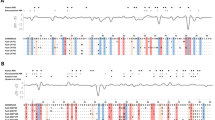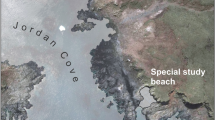Abstract
Major histocompatibility complex class II DQA and DQB genes have been shown to be under positive selection in certain mammalian species but not in others, fuelling a debate about how their polymorphism has evolved. In this study, we have analysed whether polymorphism in the peptide-binding region (PBR) of DQA (190 sequences, 11 species) and DQB (209 sequences, 7 species) molecules is positively selected by using both approximate (Nei–Gojobori, Li–Wu–Luo and Pamilo–Bianchi–Li) and maximum-likelihood methods. The results obtained with approximate methods were rather inconsistent for DQA, probably due to the high inaccuracy with which dS (PBR) is estimated, whereas evidence of positive selection was observed for most of the DQB PBR sequences. A parallel analysis with CodeML allowed us to demonstrate, in a very consistent way, the occurrence of positive selection in the PBR-encoding region of both DQA and DQB genes. Moreover, we have identified several DQA (α47, α55, α56, α68, α69, α76 and α79) and DQB (β9, β26 and β57) codons that appear to be under positive selection in different, and often unrelated, mammalian species. Non-synonymous polymorphism at these sites has been evolutionarily conserved meaning that it might have functional consequences on peptide binding.
This is a preview of subscription content, access via your institution
Access options
Subscribe to this journal
Receive 6 digital issues and online access to articles
$119.00 per year
only $19.83 per issue
Buy this article
- Purchase on Springer Link
- Instant access to full article PDF
Prices may be subject to local taxes which are calculated during checkout
Similar content being viewed by others
References
Hughes AL, Yeager M . Natural selection and the evolutionary history of major histocompatibility complex loci. Front Biosci 1998; 3: 509–516.
Yeager M, Hughes AL . Evolution of the mammalian MHC: natural selection, recombination, and convergent evolution. Immunol Rev 1999; 167: 45–58.
Goldfeld AE, Delgado JC, Thim S, Bozon MV, Uglialoro AM, Turbay D et al. Association of an HLA-DQ allele with clinical tuberculosis. JAMA 1998; 279: 226–228.
Roe DL, Lewis RE, Cruse JM . Association of HLA-DQ and -DR alleles with protection from or infection with HIV-1. Exp Mol Pathol 2000; 68: 21–28.
Hong X, Yu RB, Sun NX, Wang B, Xu YC, Wu GL . Human leukocyte antigen class II DQB1*0301, DRB1*1101 alleles and spontaneous clearance of hepatitis C virus infection: a meta-analysis. World J Gastroenterol 2005; 11: 7302–7307.
Erlich H, Valdes AM, Noble J, Carlson JA, Varney M, Concannon P et al. DR-DQ haplotypes and genotypes and type 1 diabetes risk: analysis of the type 1 diabetes genetics consortium families. Diabetes 2008; 57: 1084–1092.
Koay LB, Sun CS, Tsai SL, Lin CY . Significant association of HLA-DQ5 with autoimmune hepatitis in Taiwan. J Formos Med Assoc 2007; 106: 1063–1068.
Garrigan D, Hedrick PW . Perspective: detecting adaptive molecular polymorphism: lessons from the MHC. Evolution Int J Org Evolution 2003; 57: 1707–1722.
Pfau RS, Van Den Bussche RA, McBee K, Lochmiller RL . Allelic diversity at the Mhc-DQA locus in cotton rats (Sigmodon hispidus) and a comparison of DQA sequences within the family muridae (Mammalia: Rodentia). Immunogenetics 1999; 49: 886–893.
De Bellocq JG, Delarbre C, Gachelin G, Morand S . Allelic diversity at the Mhc-DQA locus of woodmouse populations (Apodemus sylvaticus) present in the islands and mainland of the northern Mediterranean. Glob Ecol Biogeogr 2005; 14: 115–122.
Bryja J, Galan M, Charbonnel N, Cosson JF . Duplication, balancing selection and trans-species evolution explain the high levels of polymorphism of the DQA MHC class II gene in voles (Arvicolinae). Immunogenetics 2006; 58: 191–202.
Nei M, Kumar S . Molecular Evolution in Phylogenetics. Oxford University Press Publishers: Oxford, 2000, pp 51–69.
Fremont DH, Monnaie D, Nelson CA, Hendrickson WA, Unanue ER . Crystal structure of I-Ak in complex with a dominant epitope of lysozyme. Immunity 1998; 8: 305–317.
Scott CA, Peterson PA, Teyton L, Wilson IA . Crystal structures of two I-Ad-peptide complexes reveal that high affinity can be achieved without large anchor residues. Immunity 1998; 8: 319–329.
Ronquist F, Huelsenbeck JP . MrBayes 3: Bayesian phylogenetic inference under mixed models. Bioinformatics 2003; 19: 1572–1574.
Rozas J, Sanchez-Delbarrio JC, Messeguer X, Rozas R . DnaSP, DNA polymorphism analyses by the coalescent and other methods. Bioinformatics 2003; 19: 2496–2497.
Reche PA, Reinherz EL . Sequence variability analysis of human class I and class II MHC molecules: functional and structural correlates of amino acid polymorphisms. J Mol Biol 2003; 331: 623–641.
Nei M, Gojobori T . Simple methods for estimating the numbers of synonymous and nonsynonymous nucleotide substitutions. Mol Biol Evol 1986; 3: 418–426.
Li WH, Wu C, Luo CC . A new method for estimating synonymous and nonsynonymous rates of nucleotide substitution considering the relative likelihood of nucleotide and codon changes. Mol Biol Evol 1985; 2: 150–174.
Pamilo P, Bianchi NO . Evolution of the Zfx and Zfy, genes: rates and interdependence between the genes. Mol Biol Evol 1993; 10: 271–281.
Yang Z . PAML: a program package for phylogenetic analysis by maximum likelihood. Comput Appl Biosci 1997; 13: 555–556.
Yang Z, Wong WS, Nielsen R . Bayes empirical Bayes inference of amino acid sites under positive selection. Mol Biol Evol 2005; 22: 1107–1118.
Zhang Z, Yu J . Evaluation of six methods for estimating synonymous and nonsynonymous substitution rates. Genomics Proteomics Bioinformatics 2006; 4: 173–181.
Bennetzen JL, Hall BD . Codon selection in yeast. J Biol Chem 1982; 257: 3026–3031.
Wright F . The ‘effective number of codons’ used in a gene. Gene 1990; 87: 23–29.
Hirsh AE, Fraser HB, Wall DP . Adjusting for selection on synonymous sites in estimates of evolutionary distance. Mol Biol Evol 2005; 22: 174–177.
Yang Z, Nielsen R . Synonymous and nonsynonymous substitution rates under realistic evolutionary models. Mol Biol Evol 2000; 17: 32–43.
Anisimova M, Nielsen R, Yang Z . Effect of recombination on the accuracy of the likelihood method for detecting positive selection at amino acid sites. Genetics 2003; 164: 1229–1236.
Cullen M, Perfetto SP, Klitz W, Nelson G, Carrington M . High-resolution patterns of meiotic recombination across the human major histocompatibility complex. Am J Hum Genet 2002; 71: 759–776.
Hickford JG, Zhou H, Fang Q . Haplotype analysis of the DQA genes in sheep: evidence supporting recombination between the loci. J Anim Sci 2007; 85: 577–582.
Nepom BS, Nepom GT, Coleman M, Kwok WW . Contribution of β chain residue 57 in peptide binding ability of both HLA-DR and -DQ molecules. Proc Natl Acad Sci USA 1996; 93: 7202–7206.
Mikko S, Roed K, Schmutz S, Andersson L . Monomorphism and polymorphism at Mhc DRB loci in domestic and wild ruminants. Immunol Rev 1999; 167: 169–178.
Acknowledgements
Costs of this publication have been defrayed by grant AGL2007-66707-C02 awarded by the Spanish Ministry of Education and Science to MA.
Author information
Authors and Affiliations
Corresponding author
Additional information
Supplementary Information accompanies the paper on Genes and Immunity website (http://www.nature.com/gene)
Supplementary information
Rights and permissions
About this article
Cite this article
Amills, M., Ramírez, O., Tomàs, A. et al. Positive selection on mammalian MHC-DQ genes revisited from a multispecies perspective. Genes Immun 9, 651–658 (2008). https://doi.org/10.1038/gene.2008.62
Received:
Revised:
Accepted:
Published:
Issue Date:
DOI: https://doi.org/10.1038/gene.2008.62
Keywords
This article is cited by
-
Investigating the development of diarrhoea through gene expression analysis in sheep genetically resistant to gastrointestinal helminth infection
Scientific Reports (2022)
-
Islands and hybrid zones: combining the knowledge from “Natural Laboratories” to explain phylogeographic patterns of the European brown hare
BMC Evolutionary Biology (2019)
-
Comparative analysis of host resistance to Sarcoptes scabiei var. cuniculi in two different rabbit breeds
Parasites & Vectors (2019)
-
Genetic diversity comparison of the DQA gene in European rabbit (Oryctolagus cuniculus) populations
Immunogenetics (2015)
-
Genetic diversity and differentiation of the rhesus macaque (Macaca mulatta) population in western Sichuan, China, based on the second exon of the major histocompatibility complex class II DQB (MhcMamu-DQB1) alleles
BMC Evolutionary Biology (2014)



